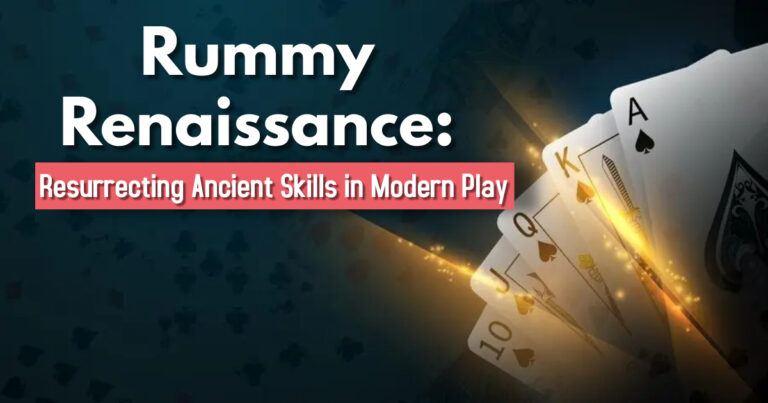From Origins to Innovation: The Evolution of the Teen Patti Games
Teen Patti games, a traditional card game that has captivated millions, embodies a rich history that weaves together cultural evolution, technological advancements, and social dynamics. Often referred to as the “Indian Poker,” Teen Patti has evolved significantly from its ancient origins to its contemporary digital form. This exploration delves into the journey of Teen Patti, tracing its roots, examining its historical transformations, and highlighting the innovations that have shaped its modern iteration, including influences from the Rummy game.

Origins and Early Beginnings of Teen Patti Games
Teen Patti, also known as “Three Cards,” finds its origins in the Indian subcontinent, with its history intertwined with the cultural tapestry of the region. Its roots can be traced back to the ancient game of “Flush,” which was played with a similar deck of cards and basic rules. The game was popular among the Indian royalty and was often associated with the festive and celebratory occasions of the time.
The exact origins of Teen Patti games are somewhat murky, but it is believed to have been played for centuries in various forms. The game, including its popular versions like Teen Patti Stars, was traditionally played with a standard deck of 52 cards and involved betting and bluffing strategies. The core concept of Teen Patti revolves around players receiving three cards each, with the goal of having the best hand or convincing opponents to fold.
Cultural Significance and Traditional Gameplay
Teen Patti’s traditional gameplay has remained relatively consistent over the years. The game typically involves betting rounds, where players, including young players, place bets based on the strength of their hands or their ability to bluff. The hand rankings, which include sequences such as “Pure Sequence” and “Trail,” have remained a fundamental aspect of the game.
Culturally, Teen Patti games holds a special place in Indian society. It is often associated with social gatherings, family celebrations, and festivals such as Diwali. The game has transcended regional boundaries, becoming a symbol of social interaction and entertainment. In traditional settings, Teen Patti is played in homes, community gatherings, and festive occasions, creating a sense of camaraderie and connection among players.
The Influence of Technology
The digital age marked a significant turning point in the evolution of Teen Patti games. With the advent of computers and mobile devices, the game underwent a transformative shift from physical to virtual platforms. The introduction of online gaming platforms and mobile apps revolutionized the way Teen Patti was played and experienced.
Online Teen Patti games platforms provided players with the convenience of accessing the game from anywhere and at any time. The digital version retained the core elements of the traditional game but introduced new features such as virtual betting, interactive interfaces, and multiplayer capabilities. This shift allowed Teen Patti games to reach a global audience, transcending geographical limitations and cultural boundaries.

Innovation and Modern Variations
The evolution of Teen Patti in the digital age has led to several innovations and modern variations of the game. Online platforms and mobile apps have introduced diverse game modes, including variations such as “Teen Patti Classic,” “Teen Patti Tournaments,” and “Teen Patti Poker.” These innovations have expanded the gameplay experience and offered players a range of options to suit their preferences.
One notable innovation is the integration of social features into online Teen Patti platforms. Players can now connect with friends, join virtual rooms, and participate in live tournaments. This social aspect has enhanced the game’s appeal, creating a dynamic and interactive environment where players can engage with others from around the world while strategizing around card ranking.
Additionally, the introduction of virtual currency and in-app purchases has added a new dimension to Teen Patti gameplay. Players can now use virtual chips and participate in premium events, further enriching the gaming experience. The availability of tutorials and practice modes has also made it easier for newcomers to learn and enjoy the game.
The Future of Teen Patti
As Teen Patti games continues to evolve, its future prospects are shaped by ongoing advancements in technology and changing player preferences. The integration of augmented reality (AR) and virtual reality (VR) technologies holds the potential to create immersive gaming experiences, blurring the lines between physical and digital play.
Furthermore, the growing trend of esports and competitive gaming may influence the future of Teen Patti games. Online tournaments and competitive leagues with varying player numbers could provide new avenues for players to showcase their skills and compete on a global scale.
The cultural significance of Teen Patti remains strong, and its adaptability to modern trends ensures that it will continue to be a cherished and evolving game. As new generations of players embrace the game, Teen Patti’s rich heritage and innovative developments will shape its trajectory in the years to come.
Conclusion
From its ancient origins to its digital innovations, Teen Patti’s journey reflects a dynamic evolution that bridges tradition and modernity. The game has seamlessly adapted to changing times, embracing technological advancements while preserving its cultural essence, embodying the essence of ‘From Tradition to Trend.’ As Teen Patti continues to captivate players worldwide, its evolution stands as a testament to its enduring appeal and relevance in the ever-changing landscape of gaming.







